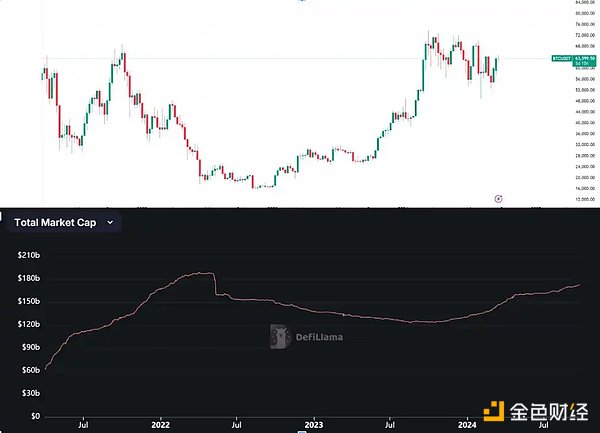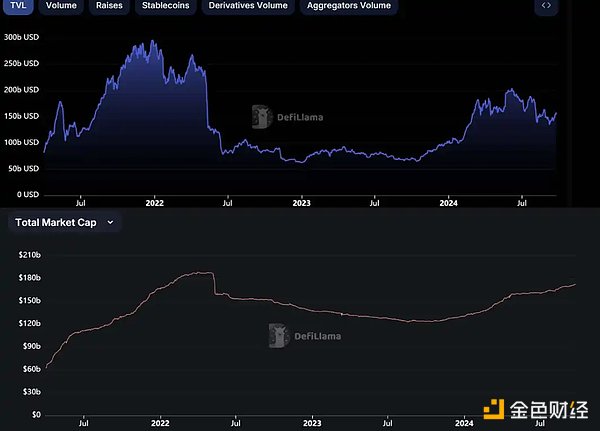Author: WOO Research
Background
On September 23, the USDC Treasury minted an additional 50 million USDC on Ethereum, which is the second time Circle has minted 50 million USDC since September. Coincidentally, another major stablecoin issuer, Tether, also minted 1 billion USDT on Ethereum on September 16.
In addition to the issuance of the two most mainstream stablecoins on the market, PayPal's PYUSD is also aggressively attacking the Solana ecosystem, partnering with the lending protocol Kamino.
According to DeFiLlama data, the overall market capitalization of stablecoins has grown from $130 billion since 2024 to the current $172 billion, an increase of 32% within the year.
The issuance of stablecoins is not like the dilution of the single value of other tokens, as the collateral behind them allows them to be pegged to one US dollar, representing the increasing demand for stablecoins in the crypto market, which is theoretically seen as a bullish signal for hot money flowing into the market.
Even though the growth of stablecoins has been evident this year, the market has been criticized for lacking liquidity and new inflows of capital in this cycle. Is the above theory proven to be false? What is the actual correlation between them and the coin prices and the overall crypto market TVL? What are the recent strategic moves of the major stablecoin issuers?
Let WOO X Research take a closer look.
US Department of Agriculture
Data Situation
USDC had a market share of 32% in March 2022, but after the collapse of Silicon Valley Bank, its market share has now dropped to only 20.6%, and its market capitalization has fallen from $55 billion to the current $35 billion.
Although the collapse of Silicon Valley Bank has had a huge impact on USDC, starting in July 2024, USDC first minted an additional 250 million USDC on Sol; in August, it continued to mint an additional 250 million USDC twice on Sol, and on Ethereum, it issued an additional 500,000 USDC twice.
Recently in September, the minting frequency on Ethereum has been increased, with 4 issuances of 50 million USDC within three weeks, totaling 200 million.
- Ethereum: 9/23 50 million, 9/10 50 million, 9/9 50 million, 8/30 50 million
- Solana: 8/8 250 million, 7/20 250 million
Circle's crazy money printing in the last three months, issuing about 800 million USDC, has also caused USDC's market capitalization to slowly rise in 2024, repairing the damage caused by the Silicon Valley Bank incident.
Recent Dynamics
The significance of the issuance, in addition to the aforementioned potential signs of hot money inflows, also represents the issuer's optimism about the overall crypto market's future.
Circle Ventures invested in a total of 12 projects in 2024, investing in 1-2 projects per month, with investment types ranging from payments, RWA tracks, and some sporadic infrastructure. Such as the recent $38 million financing of the emerging concept PayFi leader Huma Funance, and the RWA credit market Centrifuge.
Although USDC is a centralized stablecoin, it is an important underlying asset in DeFi. Circle, starting from its own business such as payments and RWA (bringing real-world assets onto the chain can be said to be the earliest RWA), has the ability to accommodate a large amount of capital in related sectors. When the market heats up and the overall TVL surges, Circle can earn on both the on-chain and off-chain sides, becoming a true money-making machine. Circle's founder Jeremy has also recently stated that they are pushing for an IPO plan.
Jeremy also stated at the Solana BreakPoint conference that they are currently exploring the combination of USDC and AI agents to ensure the flexibility and security of infrastructure such as wallets.
From USDC issuance, investment in payments, RWA, infrastructure tracks, to AI exploration, Circle is very active, and the related tracks are worth continuous attention.
Tether
Data Situation
USDT has always been the hegemon of stablecoins, with a market share of nearly 70%, with the majority of its circulating volume on TRON, accounting for nearly 50%. The overall market capitalization is as high as $120 billion, growing 33% since the beginning of this year.
USDT issuance is in units of 1 billion, with five issuances on Ethereum and TRON each this year, totaling $100 billion.
- Ethereum: 9/16 1 billion, 8/21 1 billion, 8/13 1 billion, 5/21 1 billion, 2/21 1 billion
- TRON: 8/20 1 billion, 6/15 1 billion, 5/17 1 billion, 4/4 1 billion, 1/29 1 billion
USDT dominates the stablecoin landscape, and its parent company Tether naturally makes a fortune. Tether's Q2 financial report shows a net operating profit of $1.3 billion, and $5.2 billion in the first half of 2024, a historical high.
The main revenue sources are the 0.1% fees charged for deposits and redemptions, as well as account verification fees and USDT lending interest income.
Tether, with its strong market share, has created a network effect, and has become a money printing machine in the crypto market, regardless of bull or bear.
Recent Dynamics
Unlike Circle, which expands its business from its own operations, Tether is a multi-tasker.
Recently, on September 8, it announced the acquisition of a 9.8% stake in the Latin American agricultural giant Adecoagro. In July, it announced the development of a decentralized AI model, and also invested $610 million in debt financing in the cloud-based GPU operator Northern Data Group. In June, it invested $100 million in the bitcoin mining company Bitdeer.
In April, it even announced the establishment of four new business departments, including technology, finance, energy (mining), and education, and launched its own venture capital department Tether Evo, exploring tracks beyond stablecoins.
PYUSD
Data Situation
PYUSD is not as historically established as USDT and USDC. It was launched by PayPal in 2023 and is currently only circulating on Ethereum and Solana, with a circulation ratio of about 1:1. Although the text mentions that the circulation on Ethereum and Solana is roughly equal, PYUSD only went live on Solana in May of this year, so it can be seen as the native stablecoin of the Solana ecosystem. PayPal's choice of Solana is due to its excellent settlement speed, transaction fees below one cent, and an ecosystem with over 2,500 developers.
Currently, PYUSD has a market capitalization of $722 million and has grown extremely fast since the beginning of this year, partly benefiting from Solana's rapid progress this year, with its market capitalization growing about 3 times, ranking 7th among all stablecoins.
The recent decline in circulation is attributed to the decrease in the annualized yield on PYUSD rewards in various DeFi protocols on Solana.
Originally, by depositing PYUSD into the lending protocol Kamino for lending, a risk-free yield of about 13% could be obtained, but with the end of the activity, the current yield has fallen to between 7% and 8%, reducing the willingness to deposit. The PYUSD in Kamino accounts for 78% of the total circulation on SOL, so the capital flight from the protocol has a huge impact on PYUSD, which is a risk that PYUSD holders need to consider.
Recent Dynamics
PayPal launched PYUSD in August last year, but PayPal Ventures actually had a record of investing in crypto projects as early as 2019. This year, it has 4 investments, involving three projects, including the on-chain risk control company Chaos Labs, which has participated in all three rounds of financing (seed round led in 2023).
It also includes the red-hot yield-bearing stablecoin project Ethena and the payment platform Mesh. It can be seen that PayPal's development direction still revolves around its own stablecoin and payment business.
Correlation between Stablecoin Market Cap, DeFi TVL, and Bitcoin Price
Reviewing past experiences, the correlation between stablecoin market cap and Bitcoin price is as follows:
In 2021, as Bitcoin price rose, the stablecoin market cap also increased, indicating that capital was flowing into the cryptocurrency market, and investors might have temporarily parked their funds in stablecoins, waiting for an opportunity to buy Bitcoin or other cryptocurrencies.
In 2022, with the market decline, both Bitcoin price and stablecoin market cap decreased, suggesting that capital was withdrawing from the market, with investors converting stablecoins back to fiat or directly withdrawing funds.
From 2023 to 2024, both Bitcoin price and stablecoin market cap are expected to gradually increase, indicating that the market is regaining interest, and capital is flowing back into the cryptocurrency market.
There is a strong positive correlation between Bitcoin price and stablecoin market cap. When Bitcoin price rises, the stablecoin market cap typically increases, suggesting that market capital is flowing in; conversely, when Bitcoin price declines, the stablecoin market cap also decreases, indicating that market capital is flowing out.

The trend of DeFi TVL is also strongly positively correlated with the stablecoin market cap, with the line charts almost perfectly overlapping. Recently, stablecoins have been continuously issued, and we can also expect the market to recover liquidity, whether for Bitcoin or Altcoins, as hot money continues to flow in.









